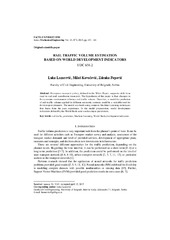| dc.creator | Lazarević, Luka | |
| dc.creator | Kovačević, Miloš | |
| dc.creator | Popović, Zdenka | |
| dc.date.accessioned | 2019-04-19T14:24:22Z | |
| dc.date.available | 2019-04-19T14:24:22Z | |
| dc.date.issued | 2015 | |
| dc.identifier.issn | 0354-2025 | |
| dc.identifier.uri | https://grafar.grf.bg.ac.rs/handle/123456789/713 | |
| dc.description.abstract | European transport policy, defined in the White Paper, supports shift from road to rail and waterborne transport. The hypothesis of the paper is that changes in the economic environment influence rail traffic volume. Therefore, a model for prediction of rail traffic volume applied in different economic contexts could be a valuable tool for the transport planners. The model was built using common Machine Learning techniques that learn from the past experience. In the model preparation, world development indicators defined by the World Bank were used as input parameters. | en |
| dc.publisher | Univerzitet u Nišu, Niš | |
| dc.relation | info:eu-repo/grantAgreement/MESTD/Technological Development (TD or TR)/36012/RS// | |
| dc.relation | Research of technical-technological, staff and organizational capacity of Serbian Railways | |
| dc.rights | openAccess | |
| dc.rights.uri | https://creativecommons.org/licenses/by-nc-sa/4.0/ | |
| dc.source | Facta universitatis - series: Mechanical Engineering | |
| dc.subject | rail traffic | en |
| dc.subject | prediction | en |
| dc.subject | Machine Learning | en |
| dc.subject | World Bank | en |
| dc.subject | development indicators | en |
| dc.title | Rail traffic volume estimation based on world development indicators | en |
| dc.type | article | |
| dc.rights.license | BY-NC-SA | |
| dc.citation.epage | 141 | |
| dc.citation.issue | 2 | |
| dc.citation.other | 13(2): 133-141 | |
| dc.citation.rank | M24 | |
| dc.citation.spage | 133 | |
| dc.citation.volume | 13 | |
| dc.identifier.fulltext | https://grafar.grf.bg.ac.rs//bitstream/id/4111/711.pdf | |
| dc.identifier.rcub | https://hdl.handle.net/21.15107/rcub_grafar_713 | |
| dc.identifier.wos | 000216540100007 | |
| dc.type.version | publishedVersion | |

